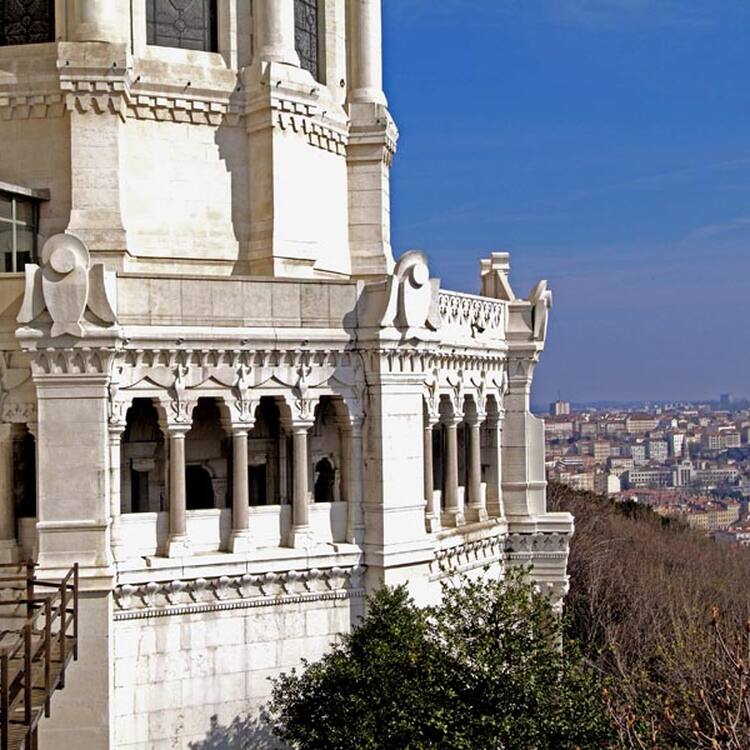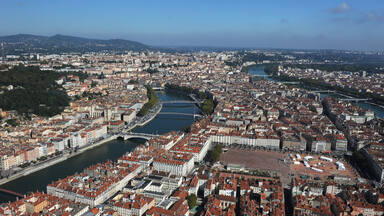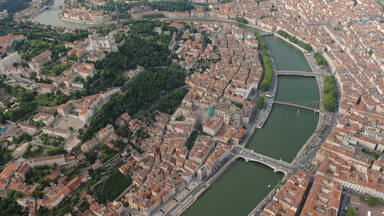Historic Site of Lyon
Historic Site of Lyon
The long history of Lyon, which was founded by the Romans in the 1st century B.C. as the capital of the Three Gauls and has continued to play a major role in Europe's political, cultural and economic development ever since, is vividly illustrated by its urban fabric and the many fine historic buildings from all periods.
Description is available under license CC-BY-SA IGO 3.0
Site historique de Lyon
La longue histoire de Lyon, fondée par les Romains en tant que capitale des Trois Gaules au Ier siècle av. J.-C. et qui n'a cessé de jouer un rôle majeur dans le développement politique, culturel et économique de l'Europe depuis cette époque, est illustrée de manière extrêmement vivante par son tissu urbain et par de nombreux bâtiments historiques de toutes les époques.
Description is available under license CC-BY-SA IGO 3.0
موقع ليون التاريخي
مدينة ليون، التي أسسها الرومان على أنها عاصمة جنرالات الغول الثلاثة في القرن الأول قبل الميلاد، والتي استمرتّ في تأدية دور ريادي في التطور السياسي والثقافي والاقتصادي لأوروبا منذ تلك الفترة، يبرز دورها في غاية من الحيوية من خلال نسيجها الإنساني والعمراني ومن خلال المباني التاريخية العديدة التي تعود إلى كافة الحقبات من تاريخها الطويل.
source: UNESCO/CPE
Description is available under license CC-BY-SA IGO 3.0
里昂历史遗迹
里昂是一座历史悠久的城市,于公元前1世纪由罗马人创建,曾是高卢三朝首都,在欧洲政治、经济和文化发展中发挥了重要作用。里昂的城市建筑和各个历史时期的大量精美古建筑生动诠释了它悠久的历史。
source: UNESCO/CPE
Description is available under license CC-BY-SA IGO 3.0
Историческая часть города Лион
Лион был основан древними римлянами в I в. до н.э. как столица «Трех Галлий». С тех пор город продолжал играть важную роль в политическом, культурном и экономическом развитии Европы. Его долгая история ярко проиллюстрирована городской застройкой и многочисленными прекрасными историческими зданиями разных периодов.
source: UNESCO/CPE
Description is available under license CC-BY-SA IGO 3.0
Sitio histórico de Lyon
La ciudad de Lyon fue fundada en el siglo I a.C. por los romanos, que establecieron en ella la capital de las Tres Galias. Desde entonces, Lyon ha desempeñado a lo largo de toda su historia un papel importante en el desarrollo político, cultural y económico de Europa. Su estructura urbana y sus numerosos monumentos de todas las épocas son vivos testimonios de esa importancia.
source: UNESCO/CPE
Description is available under license CC-BY-SA IGO 3.0
リヨン歴史地区
source: NFUAJ
Historisch gebied van Lyon
Source: unesco.nl
Outstanding Universal Value
Brief synthesis
Located in the Auvergne-Rhône-Alpes region, at the confluence of the Saône and the Rhône Rivers, the city of Lyon is dominated by two hills: Fourvière to the west and Croix-Rousse to the east.
The long history of Lyon, from a proto-urban agglomeration from the Celtic era to its founding by the Romans with the capital of Trois Gaules in the 1st century BC, has continued to play a major role in Europe’s political, cultural and economic development, and is vividly illustrated by its urban fabric and the many fine historic buildings dating from all periods.
Humans have settled at this site destined for urbanization for more than two thousand years and built a city whose stages of development are still visible today: from the Roman vestiges of antique Lugdunum to the medieval streets on the slopes of Fourvière and the Renaissance dwellings of Vieux-Lyon, from the peninsula with a wealth of classical architecture to the slopes of Croix-Rousse with its very particular canut dwellings, which bear witness to an essential page in the history of the labouring classes of the 19th century.
Among the outstanding examples are the Thomassin House, on the Place du Change (late 13th century, enlarged in the 15th century); the Claude de Bourg House (1516), the house of the poet Maurice Scève (1493, additional storey in the 17th century), the Chamberlain’s mansion (1495-1516), illustrating the transition from Gothic to French Renaissance style, the Mannerist House of the Lions (1647), the classical building on the Quai Lassagne (1760), and the “House of 365 Windows” and the “Courtyard of the Voracious”, striking examples of the tenements built for the canuts in the first half of the 19th century.
Among the public buildings, mention should be made of the late 11th-century Manécanterie (scola cantorum); the Ainay Abbey Church (1107), of pure Romanesque style; the Cathedral of St John the Baptist (1160-1481), which retains a remarkable degree of stylistic homogeneity, despite the long period of construction; the Church of St Nizier, begun in the 14th century and completed in 19th century, with its Flamboyant Gothic nave, its typical classical Renaissance façade and its neo-Gothic spire; the imposing Hôtel de Ville (1646-1703); the 17th-18th century Hôtel-Dieu built over a medieval original; the Loge du Change (1745-80), now in use as a Protestant church; the Fourvière Basilica (1872-96), one of the most important landmarks of the city; and the Weaving School, the work of modernist architect Tony Garnier (1927-1933).
The specificity of Lyon is its progressive expansion towards the east while preserving, at each stage of its growth, the richness of its earlier dwellings. Unlike many other cities where the centre was destroyed in order to be rebuilt in the same place with new architecture, Lyon’s centre has shifted location, enabling the safeguarding of whole districts whose permanence renders the history of the city visible on the buildings themselves.
Criterion (ii): Lyon bears exceptional testimony to the continuity of urban settlement over more than two millennia on a site of great commercial and strategic significance, where cultural traditions from many parts of Europe have come together to create a coherent and vigorous continuing community.
Criterion (iv): By virtue of the particular manner in which it has developed spatially, Lyon illustrates in an exceptional way the progress and evolution of architectural design and town planning over many centuries.
Integrity
On this exceptional urban fabric, inscribed in the medieval precinct that endured until the 19th century, the majority of the conserved buildings represent a long period of its development. The architectural heritage of Lyon is representative of all periods from the Middle Ages until today, including significant Gallo-Roman elements. The threats to the integrity are essentially due to opening-up and redevelopment since the 19th century, as well to modifications to buildings (mainly raising), due to continued and dynamic human occupation of this urban centre of prime importance.
Authenticity
The site of Lyon presents high authenticity through the permanence of three principal characteristics that define its town planning, the development of which is unique: the confluence, the coherence of the urban model and urbanity.
Located at a very specific geographical and geomorphological site, (the confluence of two rivers and three hills), the city was established at the crossing point of the trading thoroughfares between the influences of northern and southern Europe.
Moreover, Lyon represents, with its urban construction of more than two millennia, a development of its unique town planning: instead of rebuilding on itself, the city progressively expanded towards the east, thus conserving all the forms of town planning of the different eras alongside each other. Furthermore, the town planning models and the architectural styles developed and improved over the centuries and continued to evolve without interruption.
With its unusual town planning, the city has always been characterised by important human occupation, still evident today. The city is typologically and architecturally permeated by its uses (commerce, craft, industry, teaching, religion…) and the expression of powers (civil, religious, hospitable, merchant, bourgeois, canut, industrial…).
Protection and management requirements
The architectural and urban management provisions integrate the regulatory tools of the Heritage Code (preventive archaeology, Historic Monuments and their boundaries, remarkable heritage sites of Vieux Lyon, with a safeguarding and enhancement plan, and the Slopes of the Croix-Rousse), the Environment Code (inscribed site), and the local urbanism plan. In addition, there are operational tools (State-City Heritage Conventions, Architectural and Urban Quality Charter, Rehabilitation Charter, Illumination Plan, Restoration Plan of the Traboules, Charter of the Public Domain of Vieux Lyon…) or coordination (Heritage Workshops).
The Management Plan also calls for a multiplicity of standards, tools and skilled actors with recognized competences. The city of Lyon coordinates action programmes that concern all the heritage chains, in close contact with the services of the metropole of Grande Lyon, the region and the State. Its principal goal is the integration of heritage management with the town planning project and awareness raising of the values of the heritage and cultural project.
The buffer zone, defined around the perimeter of the historic site, encourages the cultural and heritage reading of the territory of the contemporary city beyond the historic site.
 View photos from OUR PLACE the World Heritage collection
View photos from OUR PLACE the World Heritage collection


